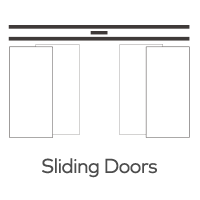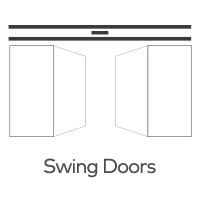How does a wireless remote control communicate with an automatic sliding door controller?
Automatic sliding doors have become a staple in modern buildings, offering convenience and accessibility. These doors often rely on wireless remote controls for operation, making them user-friendly and versatile. But how does a wireless remote control communicate with an automatic sliding door controller? In this article, we'll uncover the fascinating technology that enables this seamless interaction.

Wireless Remote Control Basics
Before delving into the communication process, it's crucial to understand how wireless remote controls work:
1. Transmitter: The remote control, also known as the transmitter, generates a unique radio frequency (RF) signal when a button is pressed.
2. Receiver: The automatic sliding door controller is equipped with a receiver that's tuned to listen for specific RF signals.
3. Signal Transmission: When a button on the remote control is pressed, it sends an RF signal containing a unique code.
4. Signal Reception: The receiver in the door controller picks up this RF signal and decodes it to interpret the command.
Communication Process
The communication between the wireless remote control and the automatic sliding door controller occurs in a series of steps:
1. Signal Generation: When you press a button on the remote control, it generates an RF signal carrying a specific code that corresponds to the desired action, such as opening or closing the door.
2. Signal Transmission: The RF signal is transmitted wirelessly through the air to the vicinity of the automatic sliding door.
3. Signal Reception: The receiver in the door controller constantly listens for incoming RF signals. When it detects a signal within its frequency range, it processes the signal to extract the code.
4. Code Verification: The receiver checks if the received code matches any of the pre-programmed codes that correspond to specific actions. If a match is found, the receiver understands the intended action.
5. Door Operation: Once the code is verified, the automatic sliding door controller initiates the programmed action, such as opening or closing the door. It does this by activating the door's motor or drive mechanism.
Security Measures
To ensure security, wireless remote controls and door controllers often employ additional measures:
Code Encryption: Many modern systems use encryption to prevent unauthorized individuals from intercepting and deciphering the RF signals.
Rolling Codes: Rolling code technology generates a new code each time the remote control is used, making it exceptionally challenging for potential intruders to clone the code.
Frequency Hopping: Some systems employ frequency hopping, where the RF signal switches between multiple frequencies during communication, further enhancing security.
Conclusion
The communication between a wireless remote control and an automatic sliding door controller is a sophisticated process that relies on RF signals, specific codes, and careful verification. This technology ensures that only authorized users can operate the door while maintaining a high level of security. Understanding this communication process demystifies the convenient operation of automatic sliding doors and highlights the importance of security features in these systems.







